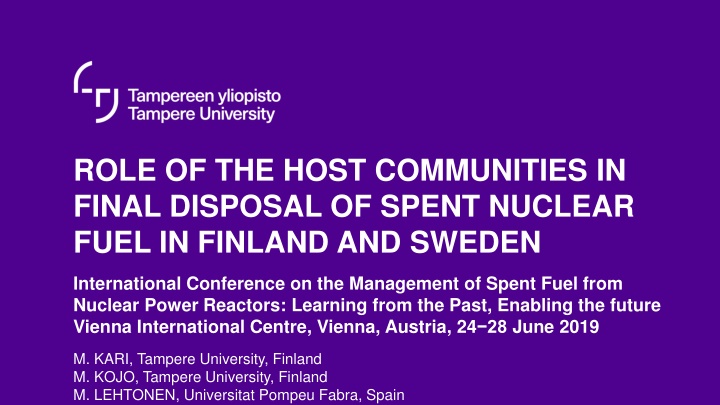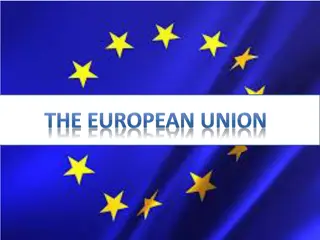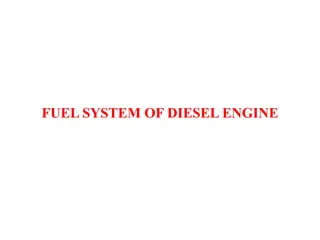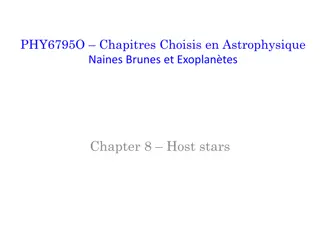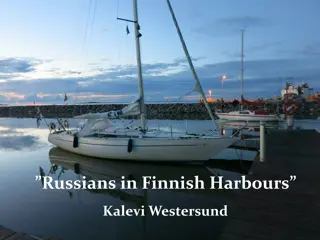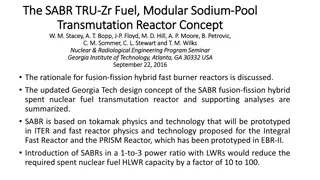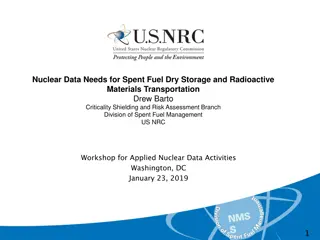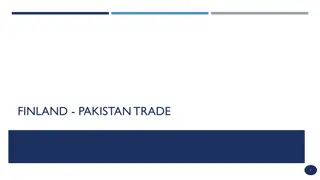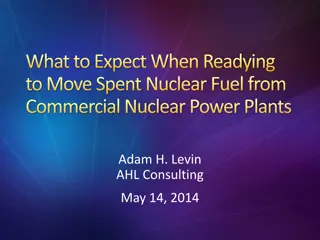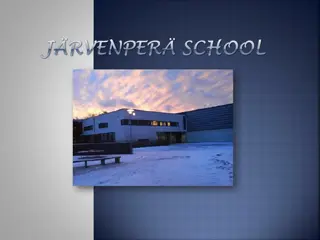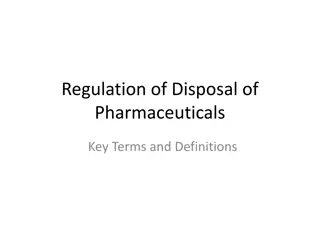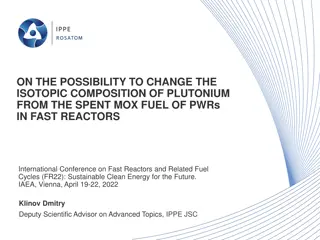Role of Host Communities in Final Disposal of Spent Nuclear Fuel in Finland and Sweden
Explore the pivotal role of local communities in managing spent nuclear fuel in Finland and Sweden through in-depth analysis of repository projects in Eurajoki and Oskarshamn. Learn about the evolution of host municipality approaches to final disposal and the shift towards collaborative and consultative decision-making processes. Discover the significance of partnership models, stakeholder involvement, and community benefits packages in achieving successful waste management strategies.
Download Presentation

Please find below an Image/Link to download the presentation.
The content on the website is provided AS IS for your information and personal use only. It may not be sold, licensed, or shared on other websites without obtaining consent from the author.If you encounter any issues during the download, it is possible that the publisher has removed the file from their server.
You are allowed to download the files provided on this website for personal or commercial use, subject to the condition that they are used lawfully. All files are the property of their respective owners.
The content on the website is provided AS IS for your information and personal use only. It may not be sold, licensed, or shared on other websites without obtaining consent from the author.
E N D
Presentation Transcript
ROLE OF THE HOST COMMUNITIES IN FINAL DISPOSAL OF SPENT NUCLEAR FUEL IN FINLAND AND SWEDEN International Conference on the Management of Spent Fuel from Nuclear Power Reactors: Learning from the Past, Enabling the future Vienna International Centre, Vienna, Austria, 24 28 June 2019 M. KARI, Tampere University, Finland M. KOJO, Tampere University, Finland M. LEHTONEN, Universitat Pompeu Fabra, Spain
CONTENTS 1. Introduction 2. Practices of partnership 3. Data 4. Flexible site selection strategies 5. Institutional arrangements 6. Municipality approahes to final disposal in sthammar, Sweden Eurajoki, Finland 7. Conclusions
Introduction The purpose is to explore the role of the local communities as actors in SNF management via an examination of the repository projects in Eurajoki and sthammar. Focus on the long-term evolution of host municipality approaches to final disposal of SNF Both Finland and Sweden have been considered as examples of countries where partnering has been implemented. Eurajoki sthammar (Source: Google)
Introduction Top-down, non-consultative siting approaches of Decide Announce and Defend (DAD), imposing radioactive waste facilities on communities, failed and were rejected by especially local publics in various countries during the 1980s and 1990s. Changes in the decision-making environment and public sensitivity required approaches entailing thorough public examination and stakeholder involvement. According to NEA the key components of a partnership approach are: - voluntarism, - formal or informal right of veto by the affected community, - collaboration with local stakeholders, and - the provision of community benefits packages.
Practices of partnership The partnership approach: semi-voluntary approach to identify a suitable site, based on site-specific repository design and local participation in decision-making through the joint development of an integrated repository project (Bergmans 2008), Key issues concerning the approach: - availability of resources and time, - relative independence of a local partnership, - co-design and co-ownership, and - stepwise decision-making (Bergmans 2008). NEA s definition of the partnership approach: a formal or informal arrangement between the radioactive waste management implementer and representatives of the local community to work together to assess technical and socio-economic issues , NEA: the regulator can be part of the partnership or is usually at least aware of it.
Data Eurajoki: sthammar: Municipal documentation and the minutes of three liaison committees: 1) The liaison committee between Eurajoki municipality and the nuclear utility TVO 2) The joint committee focused on bedrock investigations between TVO and Eurajoki 3) The Vuojoki working party, established in 1998, dedicated to discussion on further cooperation between Eurajoki and Posiva. Unfortunately, despite many requests, TVO refused to give the copies of the minutes of the latest committee established in 2013. Annual activity reports of the municipality s final disposal organisation, 1997 2018. 1) The Reference group 1997 2003, 2) The Preparatory and Reference group 2004 2005, 3) The municipality s work on SKB s site investigation 2006, 4) The Final disposal project 2007 2009, 5) The Review organisation 2010 2013 and 6) The Final disposal organisation 2014 2018.
Flexible site selection strategies in Sweden and Finland (Source: SKB; Posiva)
Voluntarism as the principle in Sweden A systematic geo-scientific research programme started at the beginning of the 1980s. Protests and opposition forced SKB to discontinue the test drillings in 1985 In 1992 SKB concluded that the selection of candidate sites should at the first stage not be based on geological considerations at all, but on pre-studies in municipalities that express an interest . SKB invited volunteers for feasibility studies. SKB s decision changed municipalities standing in the process. Both the implementer and the municipality can be seen as strategic actors negotiating their interests. SKB was able to carry out feasibility studies in eight municipalities in 1992 2000. Oskarshamn and sthammar agreed to participate in site investigations, started in 2002. SKB announced sthammar as the host community of the repository in 2009.
A semi-voluntary approach in Finland In 1985 TVO submitted to the authorities a list of 102 potential areas. Olkiluoto in Eurajoki, as the host of TVO s NPP, was added to the list based on a separate review. TVO announced the first investigation site in 1986. However, because of local resistance and media attention due to Chernobyl accident, the investigations stopped. After the failure TVO realized that local political support was needed. TVO wanted to initiate discussions with the municipalities, but did not request their formal consent before starting the investigations. In 1987, TVO named five sites for preliminary site characterization; in 1993 TVO started detailed site characterizations at three sites (incl. Olkiluoto, Eurajoki) In 1999 Posiva concluded that, as nuclear communities, Eurajoki and Loviisa would be more willing and prepared than the other two candidates to accommodate the facility. Eurajoki accepted the location of the repository in 2000
Institutional arrangements / Sweden 1) The municipalities can apply for funding from nuclear waste fund to review SKB s work and inform citizens. The municipality has a veto right. The importance of environmental legislation was enhanced and status of EIA-groups was made official. A national coordinator was appointed to coordinate information, contacts between the various actors, and efforts of the concerned municipalities. From this improved position communities were able to impose far-reaching demands on SKB. sthammar and Oskarshamn were able to influence the allocation of compensation. 2) 3) 4) 5)
Institutional arrangements / Finland 1) The cornerstone of the Finnish partnership approach is the veto right that the Nuclear Energy Act grants to the proposed host municipality. The higher rate of property tax on nuclear facilities constitutes a significant economic incentive for a host municipality. Reasons for the weak interest of the municipalities in competence-building: The missing funding for independent reviews and assessments NWM has been perceived as a purely technical issue, leaving little room for social aspects. Exceptionally strong confidence in the Finnish Radiation and Safety Authority (STUK). Safety issues were excluded from the EIA process 2)
Municipality approahes to final disposal in sthammar and Eurajoki
sthammar - Preliminary study and site investigation phases Competence-building started in 1995 after agreement on a preliminary study. - Modest but inquisitive organisation, enlisted regional university s experts. A number of questions and proposals for additions and corrections, which were reported together with SKB's responses in the end report of sthammar's preliminary study. Once SKB had supplemented its research accordingly, the site investigations were allowed on certain conditions. - Organisation was renewed 2002, as it s mandate was extended to the investigation phase. Strategy evaluation 2006: information and dialogue needs increase as SKB s decision nears. - Organisation was refined more towards providing training and knowledge for representatives and identifying potential planning needs. (Previous emphasis more on informing the municipality board) Reviewing & commenting increasing amount of reports and attending to EIA consultations - While municipality communicated directly with SKB and authorities, also participation in EIA resulted in a number of questions, which were reported together with SKB's responses
sthammar - The site selection and onwards For the best possible decision-making concerning the SKB's applications, considering also authorities and other stakeholders views, the local final disposal organisation was once again renewed in 2009. - Organisation consisted of two groups corresponding to applications (Safety + EIA), with addition of a reference group and its working group. As SKB submitted its applications in 2011, the municipality again significantly increased its activities in order to strengthen its knowledge base and inform public so that the representatives and the residents could prepare themselves for the decision about the veto. - Organisation was charged with knowledge building and revising of SKB's RD&D and preliminary EIA, actual applications and amendments. In addition, the authorities work, other stakeholders opinions, and SKB's responses were followed. - Because the approaching decision was expected to require more engagement from the municipal council, the reference group was extended to include all members of the municipal council.
Eurajoki - Preliminary and detailed site characterization phases Eurajoki was opposed to the idea of siting an SNF repository since 1982 - The municipality did not prepare for any kind of partnering activities In the late 1980s the first liaison committee between TVO and Eurajoki was established, with a focus on bedrock investigations - Aimed at exchange of information and improving knowledge on final disposal in the host municipality In 1995 Eurajoki signed a cooperation agreement with TVO - No new liaison committee, but the two existing joint committees continued their work - A committee was transformed into an Eurajoki-Posiva follow-up and steering committee concerning the EIA process in 1997 - The committees established new ad hoc sub-committees as seen necessary, to complement the partnership network, e.g. to negotiate on compensation.
Eurajoki - The site selection and onwards The local council accepted the location of the repository in 2000 - The statement on Posiva s DiP application was prepared by the Vuojoki working group - In 2008, Eurajoki announced, already before the DiP phase, the community s willingness to host both the planned new NPP unit and the SNF it would produce - Until now Eurajoki has accepted the extension of the SNF repository twice In Eurajoki s statement on the construction license application for the Posiva SNF facility in 2013 the municipality relied on STUK s expertise in safety assessment - No new committees were established Partnering arrangements between Eurajoki and the nuclear industry were rearranged in 2013 as the two liaison committees (Eurajoki-TVO and Eurajoki-Posiva) were merged. - NWM is again only one amongst many nuclear-related issues on the local agenda
Conclusions The main components of partnering have been applied differently in Sweden and Finland. This is partly due to differences in the evolution of the site selection strategies and subsequent institutional arrangements. For instance, - in Sweden the municipalities can apply for funding for review and information activities, whereas - in Finland, institutional arrangements do not empower and encourage potential host communities to undertake such activities, but instead ensure that a host community has an economic incentive to host a facility. Apparently similar Nordic high-trust contexts nevertheless produce distinct partnership approaches, following from choices made throughout the entire process.
Conclusions sthammar has adopted an active role as an involved host community - seeking to strengthen its competence, - posing demands on the implementer and the authorities, - challenging policies and actions, - actively engaging public and local actors in project planning sthammar has gained more independence in relation to the NWM company. Eurajoki has taken somewhat of a role of a bystander - holding a high level of trust in the safety regulator - tending primarily to municipal economic interests The structure of the partnership reflects a close relationship with the implementer and the nuclear utility, and delegation of safety issues to the regulator.
Thank you for your attention! This work was funded by the Finnish Research Programme on Nuclear Waste Management (KYT2018).
